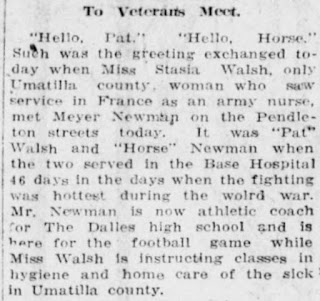Following the story of Base Hospital 46 Nurse Stasia Walsh, R.N. after her First World War service reveals many compelling things about nursing, war service, and postwar medical humanitarian work. Over the next several posts I'll explore these issues and others such as citizenship, naturalization, and wartime and postwar service and how the Pendleton, Oregon newspaper the
East Oregonian chronicled this "hometown" woman's service.
 |
Stasia Walsh,
Grace Phelps Papers, Box 3, Binder 5, Base Hospital 46 Staff
Files, Historical Collections & Archives,
Oregon Health & Science
University. Courtesy Historical Collections & Archives, OHSU.
|
From the records in the Grace Phelps Papers at the Historical Collections & Archives at the Oregon Health & Science University in Portland, we learn that Walsh was born in Ireland in 1888 and trained at the Mercy Hospital Training School for Nurses in Marshalltown, Iowa, graduating in 1910. She came to Pendleton, Oregon before the war and worked in private duty nursing. Walsh served with Base Hospital 46 and then remained with some of the staff, including Chief Nurse Grace Phelps, to continue work at Base Hospital 81 in the spring of 1919.
 |
| "Miss Stasia Walsh Arrives Home Today," Pendleton East Oregonian, July 1, 1919, 1. |
|
|
The editors of the
Pendleton East Oregonian reported her return on the front page of the July 1, 1919 edition, noting with evident pride that she was the only Pendleton woman to serve overseas with a hospital unit. Friends and colleagues from St. Anthony's Hospital greeted her. The paper noted that she had visited Italy and her home country Ireland before her return.
Most members of the Army Nurse Corps in the First World War were first Red Cross nurses who then entered the Army as reserve nurses through the Red Cross. Walsh maintained her connection with the Red Cross upon her return to Eastern Oregon. That September, the Red Cross appointed her as a lecturer to cover Umatilla County "on home hygiene and the care of the sick."
 |
| "Miss Stasia Walsh is Appointed by R.C.," Pendleton East Oregonian, September 27, 1919, 1. |
As the field of social work expanded, nurses were in high demand for work on the public health home front.
 |
| "Several Classes May be Conducted Here in Home Hygiene Course," Pendleton East Oregonian, October 4, 1919, Sec. 2:7 |
The
East Oregonian described the lessons that Walsh taught to young women (high school students) and older women for home hygiene. The Red Cross built lesson content on the idea that scientific medical training would empower women to handle health care in their homes and communities, part of a public health revolution. But the lessons also reinforced the idea that women would primarily be operating as unpaid workers in the home. Interestingly, the lessons for the 1919-1920 year would be free. Students needed to invest one dollar for a textbook.
 |
| "Red Cross Workers Visit Ill in City and Help Nearby Towns," Pendleton East Oregonian, January 29, 1920, 1. |
As a nurse working at Base Hospital 46 in France, Stasia Walsh did not contract influenza during the pandemic in the fall of 1918; she certainly dealt with patients and colleagues who had the disease. There were subsequent waves of influenza after the war, and Walsh and her Red Cross colleagues volunteered to assist Oregonians in Umatilla County who were suffering from influenza in January 1920. The
Pendleton East Oregonian reported that Walsh went to the city of Hermiston, "where she will have charge of the Red Cross Relief Work in checking the epidemic." It's interesting to note that the Red Cross provided food trays to families affected by the epidemic, some hundred strong.
More on Stasia Walsh in the next post.















